 |

 IBM-AUSTRIA - PC-HW-Support 30 Aug 1999
IBM-AUSTRIA - PC-HW-Support 30 Aug 1999 |
PCI SSA-RAID (Cluster) Adapter
For IBM SSA RAID Cluster Adapter see >  Installation and User's Guide
Installation and User's Guide
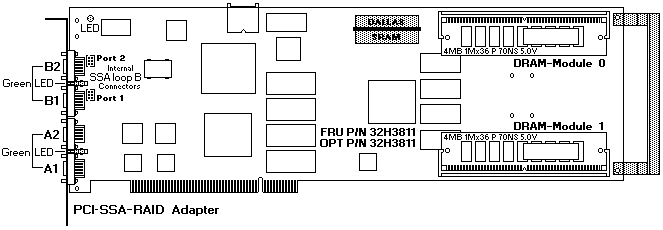
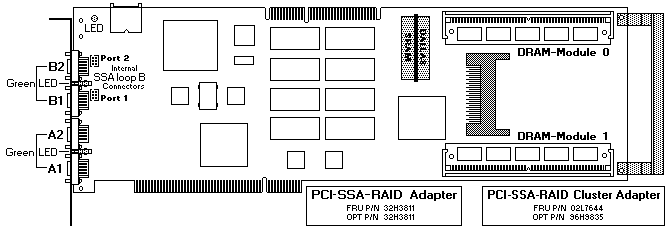
The IBM PCI SSA-RAID Controller
The adapter has four external connectors (two pairs of SSA connectors).
Connectors A1 and A2 are always paired off together and Connectors B1 and B2 are always paired off together.
The Loop Control LED (located next to each pair of loop connectors.)
- The LED is on continuously when power is turned on to the adapter
and both ports for that loop are operational, that is, the devices
connected next to the adapter in the loop have power turned on, are connected
correctly to the adapter, and are operational.
- The LED flashes continuously if one of the ports is not operational.
- Such a condition occurs if the cable to that port is not connected correctly,
or if the device that is connected next to the adapter in the loop is not operational.
- The LED is off if both ports are not operational.
Before start repair actions - verify
See TIP > NF 5500 and NF 5500-M10 Use of SSA Adapter
See TIP > STOP SSA Event Logger before HOST Software installation
See TIP > SSA RAID Adapter restricted to RAID 5 with OVER 2GB of RAM
See TIP > Failover issues: SSA Cluster Adapter and Host SW 1.06, 1.07
If the system cannot work with the PCI-SSA adapter,
check the following:
- Is CMOS setup required to enable PCI bus parameters ?
- Is the adapter installed in a bus-master PCI slot ?
- Are all the cables connected correctly ?
- Does the configuration follow the SSA rules for this adapter ?
If the system cannot access the SSA disk drives,
check the following:
- Is power turned on to the disk drives ?
- Has the configuration utility been run for all the required disk drives,
and do they appear in the list of system resources ?
- Are the disk drives connected in a valid loop ?
- Is the light next to the adapter-loop port on, showing that
both ports are operational ?
If the system fails to boot from an SSA disk drive,
check the following:
- That there is not an IDE disk drive installed.
- That there is not a SCSI adapter with BIOS enabled installed in a
higher-priority PCI slot than the SSA adapter.
- That the CBIOS enabled.
- That the SSA device drivers are loaded before the SCSI device drivers.
- That the adddress (drive letter) of the partition from which you are trying
to boot has not changed.
(Adding extra drives can cause the addresses of existing drives to be changed.)
See > IBM SSA RAID (Cluster) Adapter  Installation and User's Guide
Installation and User's Guide
FRU P/N OPT P/N MFG P/N
----------------------------------------------------------------
IBM PCI SSA-RAID Adapter 32H3811 32H3811
----------------------------------------------------------------
IBM SSA-RAID Cluster Adapter 02L7644 96H9835 96H9848
- " - Memory (SIMM 16MB) 76H5657 89H5651
---- 3527 SSA-Options -------------------------------
1.0 m SSA external cable pair 59H7220
2.5 m SSA external cable pair 59H7221
5.0 m SSA external cable pair 59H7222
10.0 m SSA external cable pair 59H7223
25.0 m SSA external cable pair 59H7224
SSA Dummy Disk Drive Module 05J6411
-----------------------------------------------------
Two external SSA-cables are packaged with each P/N.
This allows the SSA loop to be implemented.
The 3527 can support a max. of five SSA hot-swap disk drives. If less
than five disk drives are used, SSA dummy disk drive modules must be
inserted into the empty bays to maintain continuity of the SSA loop.
SSA RAID Adapter Supported Servers
| Server |
Max. Number
of
Adapters
Supported |
BIOS-Level
Required |
PC Server 320
PCI/MCA |
1 |
19A |
PC Server 320
PCI/EISA |
1 |
M54PE-16T3B |
| PC Server 325 |
3 |
All |
| PC Server 330 |
3 |
All |
PC Server 520
PCI/MCA |
1 |
19A |
PC Server 520
PCI/EISA |
1 |
M54PE-16T3C |
| PC Server 720 |
2 |
11 |
| PC Server 704 |
3 |
7 |
(Oct-1997) Current there is no support for PC Server 310 and 315
See > SSA RAID Adapter restricted to RAID-5 with over 2GB of Memory
Note: The maximum number of adapter supported is based on how many
full-sized PCI adapters will physically fit in each server and what number have been
officially tested by IBM. Larger numbers than those listed may function correctly, but
may not be supported.
Introduction
The IBM SSA RAID Adapter is a PCI bus master adapter that serves as the interface between
systems using the Peripheral Component Interconnect (PCI) architecture and devices using the Serial Storage Architecture (SSA).
The adapter provides high performance implementation of RAID-0, RAID-1 and RAID-5. It can also provide storage
in a non-RAID configuration if required, for maximum storage space.
- SAA includes SCSI-2 commands, queuing model, status and sense bytes. It is an industry-standard interface.
- The adapter provides four SSA ports for attachment of storage devices. Each port (or connector) operates at 20MB full-duplex
using point-to-point copper cables.
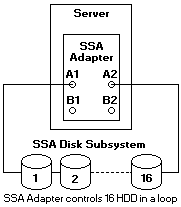
- Using standard cabling, SSA allows distances up to 25 meters (82 feet) between nodes over copper and a maximum of 2400 meters distance using fiber optic cable, where supported.
The greatest distance you can have with SCSI, from server to storage enclosure, is appr. 4.3 meters, when used in conjunction with a SCSI repeater card.
- Ports are normally used in pairs to form SSA loops.
- Up to three SSA RAID Adapters can be installed in some IBM PC Servers. This means that up to 288 disks can be connted to one server. With
9.1 GB disks, this equates to 2.6 terabytes of online storage.
- SSA has link error revovery procedures and an autom. path selection for alternative paths. There is therefore no single point of path failure on an
SSA loop.
If a loop is broken, the two connectors continue to access the devices using the remaining connections as a string. When the faulty cable is replaced, the
loop will autom. reconnect. The server need not to be brought offline, as all SSA cables and disk drives are hot swappable.
- SSA technology allows you to have huge amounts of disk storage housed in external disk storage units. The IBM PC Serverrange of SSA devices currently includes the
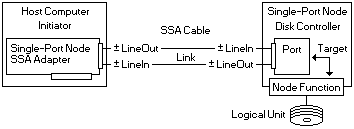
- The 3527 mini-tower enclosure is used for smaller SSA configurations and can hold up to five 2.2GB disk drives, allowing for a maximum configuration of 22.5 GB per external unit.
Up to 24 external 3527 units can populate one loop (up to a maximum of 48 drives per loop) giving you a max. of 48 ext. 3527 units on one SSA adapter, using two loops, one on each
port of the adapter.
Due to disk technology, the current maximum for disk storage on a single SSA Adapter using 3527 units is appr. 432 GB.
- The 7133 comes in either a tower rack mount form and can hold 16 - 2.2 GB, 4.5 GB or 9.1 GB SSA disk drives, allowing for a maximum configuration of 144 GB per external unit.
Up to six 7133s can be connected to one SSA adapter. Due to disk technology, the current max. for disk storage on a single SSA Adapter using 7133 units is appr. 864 GB.
The 7133 has three power and cooling supplies for redundancy. The 7133 can continue to operate if one fan or power supply fails, and it can be replaced while the 7133 is still operating.
It also has a fiber optic extender on particular models, allowing to have connectivity up to 2400 meters.
- The 7133 and 3527 external units can be mixed together on an SSA loop.
- Due to the nature of SSA, disk arrays may be spanned over different external disk drive units and different loops on the same SSA Adapter.
The SSA RAID Adapter supports the following operating systems:
- Novell NetWare 4.1 and 4.11 Note 1
- Novell NetWare 4.1 SMP
- OS/2 Warp Server Version 3 Note 1
- OS/2 Warp Server SMP Note 1
- OS/2 2.11 SMP
- Windows NT 3.51 and NT 4.0 Note 1
Note 1 Device drivers for all these network operating systems (NOEs) are supplied with the adapter.
The configuration utility allows you to configure and administer the SSA configuration online from within
the operating system. There is also a DOS-based configuration that allows to configure SSA configurations offline.
(There is no DOS device driver available !)
To install the SSA RAID Configurator and Utilities on a system already running DOS, perform the following steps:
- Insert the SSA RAID DOS Configurator and Utilities diskette in the diskette drive
- Press Ctrl+Alt+Del to reboot the system
- Verify the time and date or just press Enter twice to bypass them.
At the DOS prompt type:
A:\ISSACFG
Then press Enter.
Summary
SAA is an open ANSI standard, X3T10.1. At the moment the maximum transfer rate is 80MBps (4-ports x 20MBps).
- Run data mining applications
- Run large databases
- Have very large storage needs with potential for further expansion
- Require the fastest data transfer speeds
- Require greater distance between server and disk storage
- Requireincreased fault tolerance
- Need to maintainand use a vast database in isolation from the SCSI-accessed disks, to improve performance
SSA Characteristics
Components on SSA loops are called nodes, a node can be either an Initiator or a Target.
An initiator issues commands, and targets respond with data and status.
The SSA nodes in the adapter are therefore initiators and the SSA nodes in the disk drives are targets.
Each SSA node is given a unique address (UID) at the time of its manufacture, which allows the initiators in the loop to
determine what other SSA nodes are attached to the loop.
The SSA architecture allows more than one initiator to be present in a loop. In that case, commands and data from multiple
initiators can be directed to the same or different targets and intermixed freely. Error recording in an SSA network is coordinated by one particular
initiator, known as the master initiator. This is the initiator with the highest UID. If a new initiator is added
to the network with a higher UID than those currently present, it takes over the master responsibilities for that network.
Similary, if a master initiator is removed from the SSA network, the initiator with the next higher UID takes over master responsibility.
This master handover occurs autom. w/o any user intervention.
The master initiator has two primary functions:
- The node where all asynchronous alerts are sent
- Coordinator of error recovery procedures
Asynchronous alerts are used to notify the master initiator asynchronously of high-severity errors or conditions.
The basic unit of data transferred between SSA nodes in a frame which contains 1 byte describing the frame type, 4 bytes of CRC, up to 6 bytes of addressing
and up to 128 bytes of data. The data block contains either an SSA message or the user data.
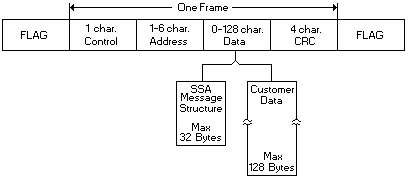
Back to 
More INFORMATION / HELP is available at the IBM-HelpCenter
Please see the LEGAL - Trademark notice.
Feel free - send a  for any BUG on this page found - Thank you.
for any BUG on this page found - Thank you.
 Installation and User's Guide
Installation and User's Guide


 Installation and User's Guide
Installation and User's Guide



 for any BUG on this page found - Thank you.
for any BUG on this page found - Thank you.